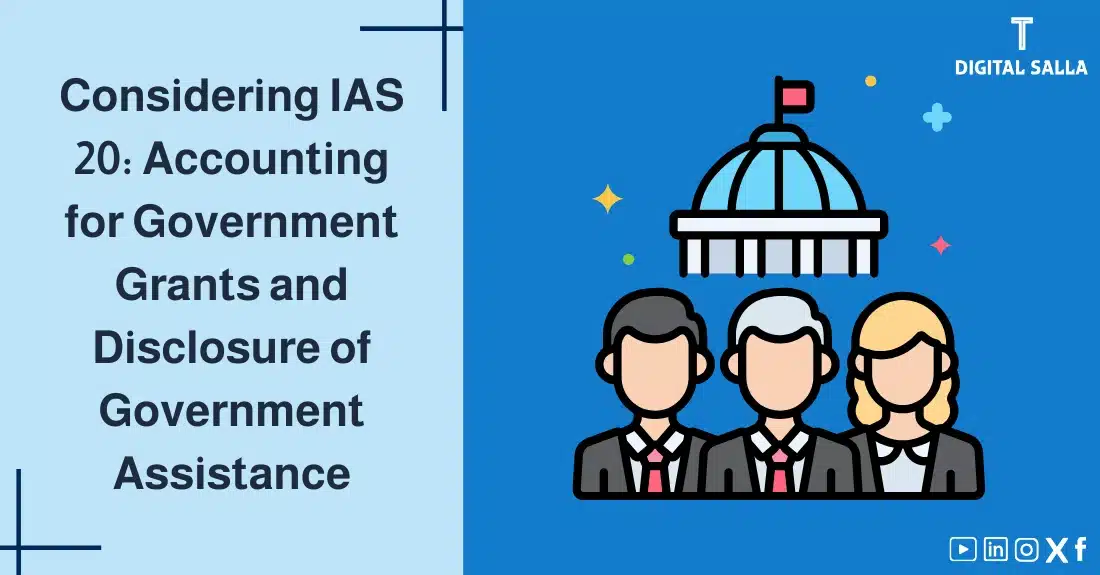Considering IAS 20 Standard: Accounting for Government Grants and Disclosure of Government Assistance

IAS 20 Standard, “Accounting for Government Grants and Disclosure of Government Assistance,” addresses how to account for and present grants received by entities from government bodies, as well as the disclosure of other forms of government assistance. IAS 20 Standard aims to ensure the proper recognition and measurement of government grants and to provide useful and transparent information about their impact on the entity’s financial statements. In this article, we will examine IAS 20 Standard, discussing its objectives, scope, and key requirements, focusing on the conditions for recognizing government grants and the methods of accounting for them, as well as highlighting the importance of this standard and its impact on financial statements.
What are Government Grants?
Government grants are assistance by a government in the form of transfers of resources to an entity in return for past or future compliance with certain conditions relating to the operating activities of the entity. They exclude those forms of government assistance which cannot reasonably have a value placed upon them and transactions with the government which cannot be distinguished from the normal trading transactions of the entity.
Examples of Government Grants:
- Cash grants for the purchase of fixed assets.
- Grants to cover research and development costs.
- Grants for employing and training staff.
- Tax exemptions linked to specific conditions.
- Interest-free or low-interest loans.
What is IAS 20 Standard: Accounting for Government Grants and Disclosure of Government Assistance?
IAS 20 Standard is an International Financial Reporting Standard (IFRS) that specifies how to account for and disclose government grants in the financial statements. The standard also addresses the disclosure of other forms of government assistance that do not qualify as grants under the accounting definition.
Objectives of IAS 20 Standard:
- Specify How to Account for Government Grants: IAS 20 Standard provides guidance on how to recognize, measure, and present government grants in the financial statements.
- Improve the Quality of Disclosures: IAS 20 Standard imposes specific disclosure requirements aimed at improving the transparency and reliability of information related to government grants and other government assistance.
- Enhance Comparability: IAS 20 Standard contributes to improving the comparability of financial statements of companies that receive government grants.
- Provide Useful Information for Decision-Making: IAS 20 Standard helps users of financial statements understand the impact of government grants on the entity’s financial position and financial performance.
Scope of IAS 20 Standard:
IAS 20 Standard applies to all government grants, regardless of their nature or form. It also applies to other forms of government assistance.
IAS 20 Standard excludes from its scope:
- The special problems arising in accounting for government grants in financial statements reflecting the effects of changing prices or in supplementary information of a similar nature.
- Government assistance that is provided for an entity in the form of benefits that are available in determining taxable profit or tax loss, or are determined or limited on the basis of income tax liability (such as income tax holidays, investment tax credits).
- Government participation in the ownership of the entity.
Recognition of Government Grants:
A government grant is not recognized until there is reasonable assurance that:
- The entity will comply with the conditions attaching to the grant.
- The grant will be received.
In other words, a grant is not recognized until it is virtually certain to be received, and the entity has met (or will meet) all obligations associated with it.
Methods of Accounting for Government Grants:
- Grants Related to Assets:
- These are government grants whose primary condition is that an entity qualifying for them should purchase, construct, or otherwise acquire long-term assets.
- Grants related to assets are recognized in the statement of financial position either:
- As deferred income: The deferred income is recognized in profit or loss on a systematic basis over the useful life of the asset.
- Or by deducting the grant from the carrying amount of the asset: The cost of the asset is reduced by the amount of the grant, and the income is recognized through a reduced depreciation expense over the asset’s life.
- Grants Related to Income:
- These are government grants other than those related to assets.
- Grants related to income are recognized in profit or loss in one of two ways:
- Presented separately: The grant is presented as a separate item within income.
- Deducted from the related expense: The grant is deducted from the expense that the grant is intended to compensate.
Accounting Treatment of Non-Monetary Grants:
Non-monetary government grants are measured either at the fair value of the non-monetary asset received or at a nominal amount.
Repayment of Government Grants:
If a government grant becomes repayable, it should be treated as a change in accounting estimate (applied prospectively).
- Grant Related to Income: The repayment is applied first against any unamortized deferred credit balance related to the grant. To the extent that the repayment exceeds any such deferred credit balance, or when no deferred credit balance exists, the repayment is recognized immediately in profit or loss.
- Grant Related to an Asset: The repayment is treated either by increasing the carrying amount of the asset or by reducing the deferred income balance, and the cumulative additional depreciation that would have been recognized to date as an expense in the absence of the grant is recognized immediately in profit or loss.
Disclosure Requirements under IAS 20 Standard:
IAS 20 Standard requires entities to disclose the following information related to government grants and other government assistance:
- The accounting policy adopted for government grants, including the methods of presentation adopted in the financial statements.
- The nature and extent of government grants recognized in the financial statements and an indication of other forms of government assistance from which the entity has directly benefited.
- Unfulfilled conditions and other contingencies attaching to government assistance that has been recognized.
- A reconciliation between the opening and closing balances of grants related to assets, showing the changes during the period.
- A reconciliation between the opening and closing balance of grants related to income, showing the changes during the period.
Importance of IAS 20 Standard for Companies:
IAS 20 Standard is an important IFRS that helps companies to:
- Comply with IFRS: IAS 20 Standard ensures that companies account for government grants consistently with IFRS.
- Improve the Quality of Financial Reporting: Applying IAS 20 Standard leads to improved quality, relevance, and reliability of financial information related to government grants.
- Enhance Investor Confidence: IAS 20 Standard helps build investor confidence by providing more accurate and transparent information about the impact of government grants on the entity’s financial position and financial performance.
- Better Manage Government Grants: IAS 20 Standard provides a clear accounting framework for government grants, helping companies manage these grants more effectively.
Challenges in Applying IAS 20 Standard:
- Determining Whether Government Assistance Falls within the Definition of a Government Grant: In some cases, it may be difficult to distinguish between government grants and other forms of government assistance.
- Identifying the Conditions of the Grant: The conditions of government grants may be complex and difficult to interpret.
- Measuring the Fair Value of Non-Monetary Grants: It may be difficult to determine the fair value of the non-monetary asset received as a government grant.
- Keeping Up with Changes in Accounting Standards: Companies must keep up with any changes or updates to IAS 20 Standard to ensure compliance with the latest requirements.
Role of Technology in Applying IAS 20 Standard:
Accounting software and Enterprise Resource Planning (ERP) systems help in applying IAS 20 Standard more efficiently and accurately through:
- Improving the accuracy and comprehensiveness of financial information related to government grants.
- Automating the process of recording and treating government grants.
- Tracking obligations related to government grants.
- Generating the reports necessary to comply with disclosure requirements.
Practical Example of Applying IAS 20 Standard:
Scenario: Company “B” received a government grant of 100,000 Riyals related to the purchase of a new machine. The purchase price of the machine is 500,000 Riyals.
Accounting Treatment:
Company “B” can choose between two methods for presenting the grant in the statement of financial position:
- Method 1: Present the grant as deferred income:
- Upon receipt of the grant:
- Debit: Cash (100,000 Riyals)
- Credit: Deferred Income – Government Grant (100,000 Riyals)
- Upon purchase of the machine:
- Debit: Machinery (500,000 Riyals)
- Credit: Cash (500,000 Riyals)
- The deferred income is recognized in profit or loss over the life of the machine in conjunction with the depreciation expense.
- Upon receipt of the grant:
- Method 2: Deduct the grant from the carrying amount of the asset:
- Upon purchase of the machine:
- Debit: Machinery (400,000 Riyals)
- Debit: Government Grant (100,000 Riyals)
- Credit: Cash (500,000 Riyals)
- The machine is depreciated based on its net cost (400,000 Riyals).
- Upon purchase of the machine:
Disclosure:
Company “B” must disclose the accounting policy used for government grants, the nature and extent of government grants recognized in the financial statements, and any unfulfilled conditions or other contingencies attached to the grant.
Note: For more comprehensive information on International Financial Reporting Standards in general, you can refer to our article: [International Financial Reporting Standards].
Conclusion:
IAS 20 Standard, “Accounting for Government Grants and Disclosure of Government Assistance,” provides a clear accounting framework for treating government grants and disclosing government assistance. Companies that receive government grants must comply with the requirements of this standard to ensure that these grants are presented fairly in the financial statements. Understanding IAS 20 Standard is essential for accountants, auditors, investors, and anyone seeking to understand how government grants affect an entity’s financial position and financial performance. As governments play an increasingly important role in supporting economic activities, IAS 20 Standard becomes increasingly important as a tool to enhance the transparency and reliability of financial reporting and support the efficiency of capital markets.
